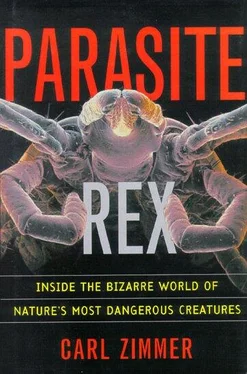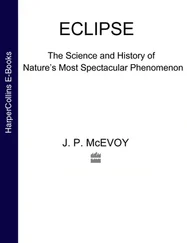Even within this one reserve, Brooks was probably not going to be able to count every parasite. Brooks is an expert on the parasites of vertebrates as parasites are traditionally defined—in other words, excluding the bacteria and viruses and fungi. When I visited him, he had identified about three hundred of these parasites, but he estimated there would be eleven thousand in total. Brooks doesn’t study the thousands of species of parasitic wasps and flies that live in the forest, devouring insects from within and keeping them alive till the last moment of their feast. He doesn’t study the plants that parasitize other plants, stealing the water their hosts pump from the ground and the food they make out of air and sun. He doesn’t study fungi, which can invade animals, plants, or even other fungi. He can only hope that other parasitologists will join him. They are spread thin over their subjects. Every living thing has at least one parasite that lives inside it or on it. Many, like leopard frogs and humans, have many more. There’s a parrot in Mexico with thirty different species of mites on its feathers alone. And the parasites themselves have parasites, and some of those parasites have parasites of their own. Scientists such as Brooks have no idea just how many species of parasites there are, but they do know one dazzling thing: parasites make up the majority of species on Earth. According to one estimate, parasites may outnumber free-living species four to one. In other words, the study of life is, for the most part, parasitology.
The book in your hand is about this new study of life. Parasites have been neglected for decades, but recently they’ve caught the attention of many scientists. It has taken a long time for scientists to appreciate the sophisticated adaptations parasites have made to their inner world, because it is so hard to get a glimpse of it. Parasites can castrate their hosts and then take over their minds. An inch-long fluke can fool our complex immune system into thinking it is as harmless as our own blood. A wasp can insert its own genes into the cells of a caterpillar to shut down the caterpillar’s immune system. Only now are scientists thinking seriously about how parasites may be as important to ecosystems as lions and leopards. And only now are they realizing that parasites have been a dominant force, perhaps the dominant force, in the evolution of life.
Or perhaps I should say in the minority of life that is not parasitic. It takes a while to get used to that.
Nature is not without a parallel strongly suggestive of our social perversions of justice, and the comparison is not without its lessons. The ichneumon fly is parasitic in the living bodies of caterpillars and the larvae of other insects. With cruel cunning and ingenuity surpassed only by man, this depraved and unprincipled insect perforates the struggling caterpillar, and deposits her eggs in the living, writhing body of her victim.
—John Brown, in
Parasitic Wealth or Money Reform: A Manifesto to the People of the United States and to the Workers of the World (1898)
In the beginning there was fever. There was bloody urine. There were long quivering strings of flesh that spooled out of the skin. There was a sleepy death in the wake of biting flies.
Parasites made themselves, or at least their effects, known thousands of years ago, long before the name parasite— parasitos —was created by the Greeks. The word literally means “beside food,” and the Greeks originally had something very different in mind when they used it, referring to officials who served at temple feasts. At some point the word slipped its etymological harness and came to mean a hanger-on, someone who could get the occasional meal from a nobleman by pleasing him with good conversation, delivering messages, or doing some other job. Eventually the parasite became a standard character in Greek comedy, with his own mask. It would be many centuries before the word would cross over to biology, to define life that drains other lives from within. But the Greeks already knew of biological parasites. Aristotle, for instance, recognized creatures that lived on the tongues of pigs, encased in cysts as tough as hailstones.
People knew about parasites elsewhere in the world. The ancient Egpytians and Chinese prescribed different sorts of plants to destroy worms that lived in the gut. The Koran tells its readers to stay away from pigs and from stagnant water, both sources of parasites. For the most part, though, this ancient knowledge has only left a shadow on history. The quivering strings of flesh—now known as guinea worms—may have been the fiery serpents that the Bible describes plaguing the Israelites in the desert. They certainly plagued much of Asia and Africa. They couldn’t be yanked out at one go, since they would snap in two and the remnant inside the body would die and cause a fatal infection. The universal cure for guinea worm was to rest for a week, slowly winding the worm turn by turn onto a stick to keep it alive until it had crawled free. Someone figured out this cure, someone forgotten now for perhaps thousands of years. But it may be that that person’s invention was remembered in the symbol of medicine, known as the caduceus: two serpents wound around a staff.
As late as the Renaissance, European physicians generally thought that parasites such as guinea worms didn’t actually make people sick. Diseases were the result of the body itself lurching out of balance as a result of heat or cold or some other force. Breathing in bad air could bring on a fever called malaria, for example. A disease came with symptoms: it made people cough, put spots on their belly, gave them parasites. Guinea worms were the product of too much acid in the blood, and weren’t actually worms at all—they were something made by a diseased body: perhaps corrupted nerves, black bile, elongated veins. It was hard to believe, after all, that something as bizarre as a guinea worm could be a living creature. Even as late as 1824, some skeptics still held out: “The substance in question cannot be a worm,” declared the superintending surgeon of Bombay, “because its situtation, functions, and properties are those of a lymphatic vessel and hence the idea of its being an animal is an absurdity.”
Other parasites were undeniably living creatures. In the intestines of humans and animals, for instance, there were slender snake-shaped worms later named Ascaris , and tapeworms—flat, narrow ribbons that could stretch for sixty feet. In the livers of sick sheep were lodged parasites in the shape of leaves, called flukes after their resemblance to flounder ( floc in Anglo-Saxon). Yet, even if a parasite was truly a living creature, most scientists reasoned, it also had to be a product of the body itself. People carrying tapeworms discovered to their horror that strips of it would pass out with their bowel movements, but no one had ever seen a tapeworm crawl, inch by inch, into a victim’s mouth. The cysts that Aristotle had seen in the tongues of pigs had little wormlike creatures coiled up inside, but these were helpless animals that didn’t even have sex organs. Parasites, most scientists assumed, must have been spontaneously generated in bodies, just as maggots appeared spontaneously on a corpse, fungus on old hay, insects from within trees.
In 1673, the visible parasites were joined by a zoo of invisible ones. A shopkeeper in the Dutch city of Delft put a few drops of old rainwater under a microscope he had built himself, and he saw crawling globules, some with thick tails, some with paws. His name was Anton van Leeuwenhoek, and although in his day he was never considered anything more than an amateur, he was the first person to lay eyes on bacteria, to see cells. He put everything he could under his microscope. Scraping his teeth, he discovered rod-shaped creatures living on them, which he could kill with a sip of hot coffee. After a disagreeable meal of hot smoked beef or ham, he would put his own loose stool under his lenses. There he could see more creatures—a blob with leglike things that it used to crawl like a wood louse, eel-shaped creatures that would swim like a fish in water. His body, he realized, was a home to microscopic parasites.
Читать дальше











